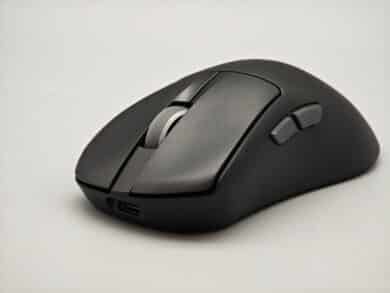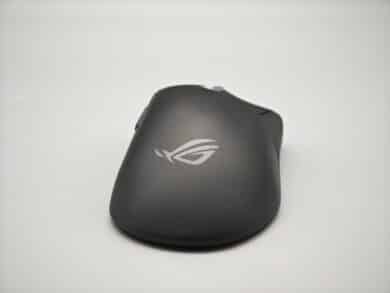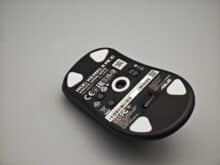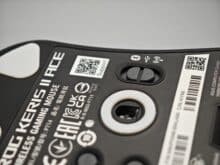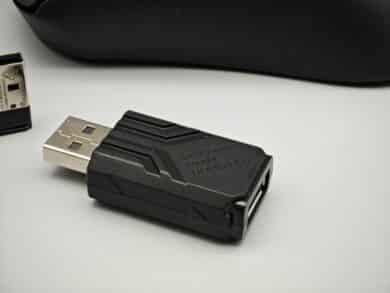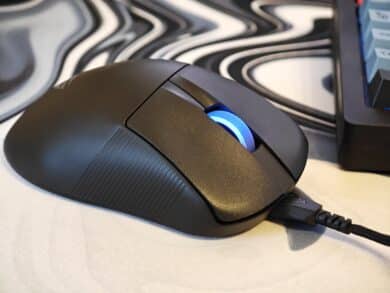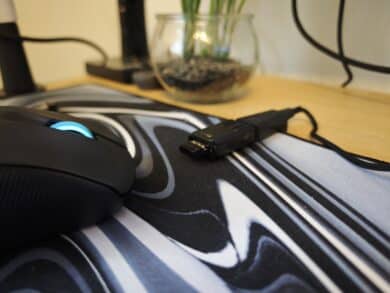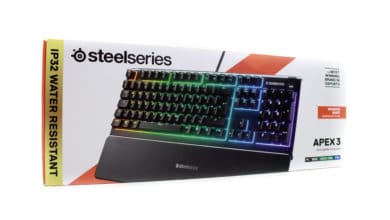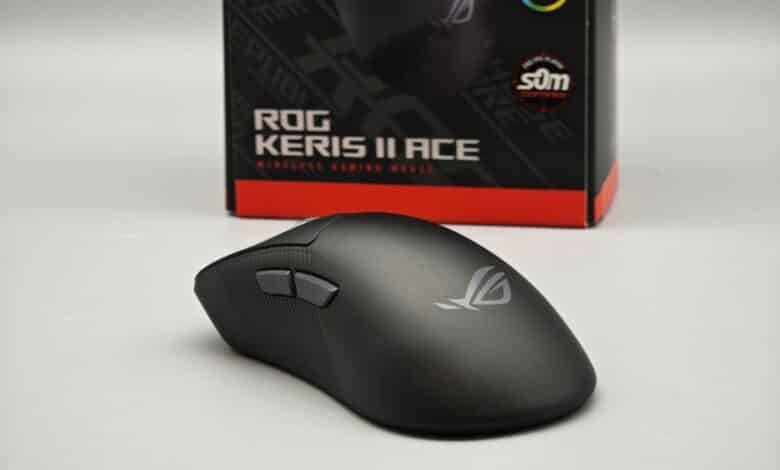
With the ASUS ROG Keris II Ace unveiled in March, the manufacturer wants to compete for the title in the field of high-performance esports mice. On the plus side, the rodent boasts a sampling rate of up to 4,000 Hz, and even 8,000 Hz via cable. Our test clarifies whether it is worth buying.
Technical data
| The product | Keris II Ace |
| Ergonomics | Ergonomic (for right-handers) |
| Sensor | ROG AimPoint Pro |
| Sensor type | Optical |
| DPI | 100 – 42.000 |
| IPS | 750 |
| Acceleration | 70G |
| Polling rate | 8.000 Hz (via cable); 4.000 Hz (wireless) |
| Hardware acceleration | None |
| Number of buttons | 7 (6 programmable) |
| Material | ABS plastic |
| Switch | ROG 100M Optical Micro Switch |
| Switch weight | 54 grams |
| Dimension | 121.2 mm x 67 mm x 42 mm |
| Cable length / material | 2 meters / fabric sheathing |
| Connection | USB type A to USB type C |
| Connectivity | Wireless (2.4 GHz receiver); wired; Bluetooth |
| Battery life | Up to 107 hours (wireless); up to 134 hours (Bluetooth) |
| Price | € 175.09 * |
ASUS ROG Keris II Ace review: Design and build quality
- small and light
- pleasantly non-slip surface
- excellent workmanship
The ASUS ROG Keris II Ace is an ergonomically shaped gaming mouse for right-handed users. Weighing in at just 54 grams, it is right up there with the best in terms of weight.
ASUS offers the rodent in either black or white and provides RGB lighting around the pleasantly ribbed scroll wheel. What I really like is the non-slip, slightly roughened surface. It feels very comfortable in the hand and provides a good grip. If you need even more grip, you will find the corresponding tapes in the scope of delivery.
In addition, the areas to the left and right (i.e. the thumb rest) next to the primary keys have a ribbed surface that further increases grip. The Keris II Ace is 121 mm long, 67 mm wide and 42 mm high – making it perfect for medium-sized and smaller hands that can use it with all grip types.
However, the two left side buttons are comparatively small, which means that the thumb has to move slightly backwards when pressing the rear button. Otherwise, the mouse is kept quite simple.
On the underside, in addition to four triangular PTFE gliding feet, you will find buttons for changing the DPI setting and pairing via Bluetooth, as well as a mode switch with which you can switch between Bluetooth, 2.4 GHz wireless and wired operation. Additional gliding feet with a larger surface area are also included with the mouse.
Performance and sensor test
- 42.000 DPI; very precise sensor
- 4.000 Hz wireless; 8,000 Hz via cable
- Bluetooth mode
One of the ASUS ROG Keris II Ace’s biggest competitors is undoubtedly the Razer Viper V3 Pro (our test), which is in the same class not only technically but also in terms of price.
One of the advantages of the ASUS model is its more powerful sensor, the ROG AimPoint Pro. This delivers up to 42,000 DPI at a maximum speed of 750 IPS and 50G acceleration. Those who like to play with high resolutions will get their money’s worth here.
Especially as the Keris II Ace can be adjusted in 50 DPI increments, so precise adjustments are possible here. Personally, this is not so important to me, as I prefer to play with a low resolution.
The precision of the sensor gives no cause for criticism. Whether on a table, glass, mouse pad or slightly raised above the surface: all movements are implemented with high precision.
The ASUS ROG Keris II Ace uses a wireless sampling rate of 1,000 Hz as standard. However, this can be increased to 4,000 Hz in wireless mode and 8,000 Hz in wired mode using the included polling rate booster, which reduces latency many times over. Razer is slightly ahead here, as it also offers 8,000 Hz in wireless mode.
Wireless use using the included paracord cable with USB-A polling rate booster proves to be very convenient, as the receiver and cable can be placed freely on the table and attached to the mouse pad.
The rodent can also be optionally connected via Bluetooth, which is of course advantageous for working as it noticeably extends the battery life. However, this also noticeably increases the latency – but this is not an option for competitive gaming.
Battery life and practical test
- up to 107 hours runtime without RGB
- comparatively low energy consumption
- durable, quiet switches
The ASUS ROG Keris II Ace relies on particularly durable ROG Optical Micro Switches for both primary keys, which are not only designed for 100 million clicks, but also trigger faster than mechanical counterparts thanks to their optical design.
Both switches offer no cause for criticism in terms of precision and triggering behavior and also score points with a very quiet and pleasant clicking noise.
The battery life naturally varies greatly depending on the selected mode, but also on the sampling rate. According to ASUS, the mouse should last up to 107 hours in 2.4 GHz wireless mode with RGB lighting deactivated, which is probably the case for a polling rate of 1,000 Hz. With RGB lighting, the runtime drops to around 67 hours.
Via Bluetooth, on the other hand, the values are 134 hours without and 89 hours with RGB, which are still very good values. As part of my ASUS ROG Keris II Ace test, I found that an increase to 4,000 Hz does have a noticeable effect on the runtime, but it doesn’t reduce it nearly as much as the aforementioned Razer counterpart.
This is also because the ROG mouse goes into sleep mode very quickly if no movements are registered. This of course saves a lot of energy. Only after around five hours of testing did the battery indicator within the Armory Crate software drop by one percent with pulsating lighting – making the Keris II Ace comparatively economical.
Software connection: Armoury Crate
Speaking of software: Armoury Crate is of course used here, which offers a familiar range of functions. In addition to the option of individually adjusting the four DPI levels in the internal memory, the buttons can be freely assigned. Of course, macros can also be saved here.
Calibration for various mouse pads from the manufacturer, including the Moonstone L (our test) made of glass, is possible; alternatively, you can also trigger the surface calibration manually.
The RGB lighting is an interesting point. This is because it can be set not only within the app, but also in the Windows options. Just a few days ago we reported on the Dynamic Lighting function of ASUS mainboards, but the Keris II Ace also uses this function.

ASUS ROG Keris II Ace review: Conclusion
No question: The ASUS ROG Keris II Ace is truly not a cheap pleasure. But if you’re prepared to spend that kind of money on a gaming mouse, you’ll get a lot in return.
With its range of functions, ASUS ROG is right up there with the best gaming mice. I particularly like the non-slip surface, which, in combination with the high-precision sensor and low weight, enables almost unparalleled performance.
The short shape should appeal to gamers with small hands in particular, although I would have liked slightly larger side buttons. On the other hand, the mouse is suitable for all grip types, even if – due to its ergonomic shape – only for right-handers.
The Bluetooth option is a nice bonus, especially to save battery power in office use or to operate the rodent on a tablet, for example. Compared to its direct competitor, the Razer Viper V3 Pro, the ASUS ROG Keris II Ace is ahead in my eyes in terms of workmanship and grip, but also in terms of battery life – even if Razer achieves a higher polling rate in wireless mode.
All in all, this results in a coherent overall package at an absolute premium price. However, if a lower resolution is enough for you, you will find significantly cheaper options with an 8K polling rate.
ASUS ROG Keris II Ace
Workmanship
Features
Ergonomics
Software
Value For Money
90/100
High-quality and extremely fast gaming mouse with a powerful sensor, impressive battery life and up to 8,000 Hz. However, the price is steep.

